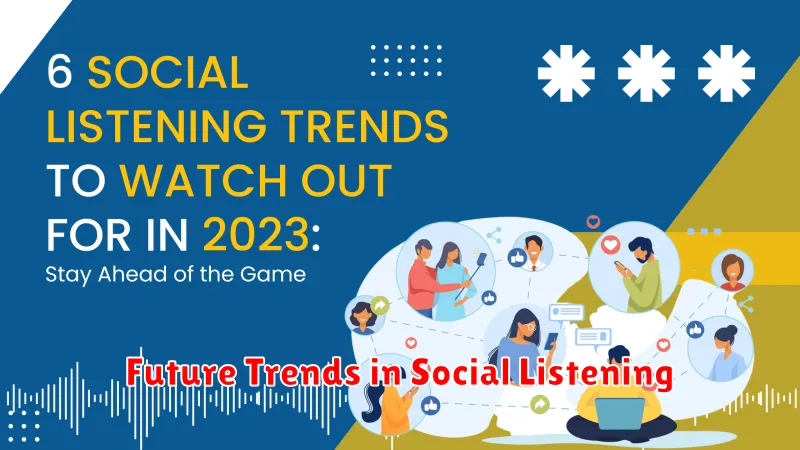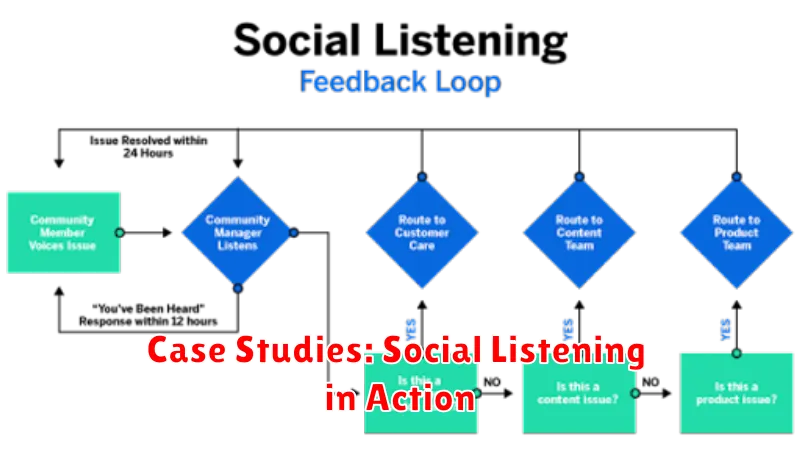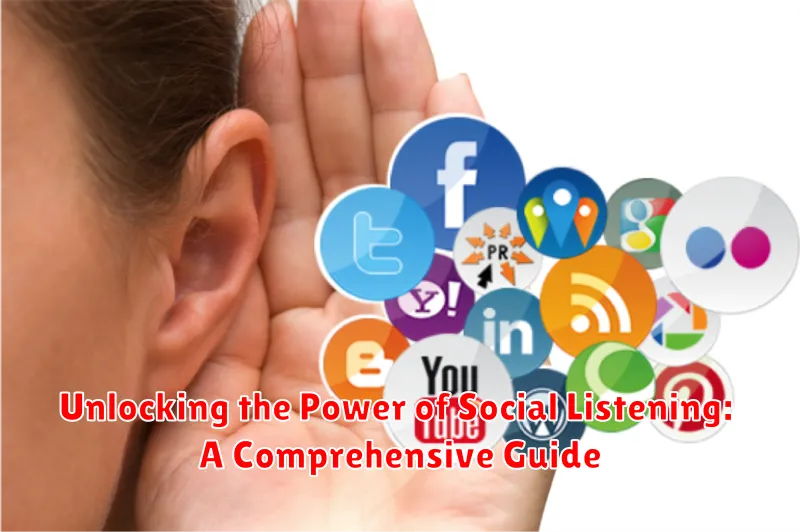In today’s digitally driven world, understanding your audience is more critical than ever. Social listening offers an unparalleled opportunity to gain invaluable insights into consumer behavior, market trends, and brand perception. This comprehensive guide delves into the power of social listening, providing a roadmap to effectively monitor online conversations, analyze data, and leverage these insights to enhance marketing strategies, improve customer service, and drive business growth. Whether you are a seasoned marketer, a business owner, or just beginning to explore the potential of social media analytics, this guide will equip you with the knowledge and tools necessary to unlock the true power of social listening.
This guide will cover everything from the fundamental concepts of social listening to advanced techniques for data analysis. We will explore the benefits of social listening, discuss various social listening tools available, and provide practical strategies for implementing social listening into your existing workflows. By the end of this guide, you will be able to confidently leverage social listening to make informed decisions, improve brand reputation, identify potential crises, and ultimately, achieve your business objectives. Prepare to discover the transformative power of social listening and its potential to revolutionize your understanding of the digital landscape.
What is Social Listening and Why is it Important?
Social listening is the process of monitoring digital conversations to understand what customers are saying about a brand, industry, or competitor online. It goes beyond simply tracking mentions; it involves analyzing the data to gain insights into consumer sentiment, preferences, and emerging trends.
Unlike social media monitoring, which primarily focuses on tracking metrics like follower count and engagement, social listening delves deeper into the meaning behind the data. It seeks to understand the “why” behind the “what.” Why are people talking about your brand? What are their pain points? What are they saying about your competitors?
The importance of social listening lies in its ability to provide invaluable, real-time data that can inform business decisions across various departments. It allows companies to identify potential crises, understand customer needs, improve product development, and ultimately, build stronger relationships with their target audience.
Key Benefits of Social Listening for Businesses
Social listening offers a wealth of advantages for businesses seeking to thrive in today’s dynamic market. By actively monitoring online conversations, brands gain access to crucial consumer insights that inform strategic decision-making.
A primary benefit is enhanced customer understanding. Social listening provides direct access to unfiltered customer feedback, revealing their needs, preferences, and pain points. This knowledge empowers businesses to tailor products, services, and marketing campaigns to better resonate with their target audience.
Improved brand reputation management is another key advantage. By tracking brand mentions and sentiment, businesses can proactively address negative feedback and mitigate potential crises. Simultaneously, they can identify and amplify positive conversations, bolstering brand image and loyalty.
Competitive analysis is significantly strengthened through social listening. Monitoring competitor activity provides insights into their strategies, strengths, and weaknesses, allowing businesses to adapt and stay ahead in the market. This includes tracking competitor campaigns, product launches, and customer interactions.
Finally, social listening facilitates targeted marketing and lead generation. By identifying individuals expressing interest in relevant products or services, businesses can engage directly with potential customers, leading to increased conversion rates and business growth.
How to Effectively Implement Social Listening
Effectively implementing social listening requires a strategic approach. Begin by defining clear objectives. What do you hope to achieve through social listening? Are you aiming to improve customer service, track brand perception, or identify emerging trends?
Next, identify relevant keywords and hashtags related to your brand, industry, and competitors. These will form the basis of your listening efforts. Consider variations and misspellings to ensure comprehensive coverage.
Choose the right social listening tools. Numerous platforms offer varying features and functionalities. Select tools that align with your budget and objectives. Experimentation may be necessary to find the optimal fit.
Establish a structured monitoring process. Regularly review the data collected, paying close attention to sentiment analysis and recurring themes. Document your findings and share them with relevant teams within your organization.
Finally, integrate social listening into your overall marketing strategy. The insights gleaned should inform your content creation, customer engagement, and product development efforts.
Tools and Techniques for Social Listening
Effectively leveraging social listening requires utilizing the right tools and techniques. A variety of platforms are available, ranging from free basic options to comprehensive enterprise-level suites. Choosing the right tools depends on your specific needs and budget.
Free tools like Google Alerts can monitor mentions of specific keywords. While limited in functionality, they offer a starting point for basic tracking.
Dedicated social listening platforms provide more advanced features. These often include sentiment analysis, influencer identification, and comprehensive reporting dashboards. Some popular platforms include Brandwatch, Mention, and SproutSocial.
Beyond platform selection, effective keyword research is crucial. Identifying relevant keywords and hashtags related to your brand, industry, and competitors is essential for targeted listening. Boolean search operators (AND, OR, NOT) can refine searches and filter irrelevant noise.
Setting up automated alerts ensures timely notification of important conversations. This enables quick responses to emerging trends, customer feedback, and potential crises.
Analyzing Social Listening Data for Actionable Insights
Gathering social listening data is only the first step. The true power lies in analyzing this data to extract actionable insights. This process involves identifying patterns, trends, and sentiments within the collected data.
Start by organizing your data using relevant categories, such as demographics, product mentions, or competitor activity. Look for recurring themes and keywords that reveal customer preferences, pain points, and emerging trends. Sentiment analysis tools can help gauge the overall emotional tone surrounding your brand and specific topics.
Key performance indicators (KPIs) play a crucial role in measuring the effectiveness of your social listening efforts. Track metrics such as brand mentions, sentiment scores, and engagement rates to assess the impact of your strategies. Use data visualization tools to create charts and graphs that illustrate these trends and make it easier to identify areas for improvement.
Finally, connect your insights to business objectives. Understanding customer sentiment and emerging trends can inform product development, marketing campaigns, and customer service strategies. By analyzing social listening data effectively, businesses can make data-driven decisions that lead to tangible results.
Best Practices for Social Listening Success
Successfully integrating social listening requires a strategic approach. Follow these best practices to maximize its impact:
Define Clear Objectives. Start with well-defined goals. What do you hope to achieve with social listening? Is it improved customer service, competitive analysis, or campaign optimization? Clear objectives guide your listening efforts.
Focus on Relevant Keywords. Identify keywords and phrases relevant to your brand, industry, and competitors. This focused approach ensures you’re capturing the most relevant conversations.
Regularly Monitor and Analyze. Social listening isn’t a one-time activity. Consistent monitoring and analysis are crucial for identifying emerging trends and responding to customer needs in a timely manner.
Integrate with Other Data Sources. Combine social listening data with other data sources like customer relationship management (CRM) and website analytics to gain a holistic understanding of your audience.
Document and Share Insights. Create reports and presentations to share key findings and insights with relevant stakeholders across your organization.
Social Listening and Brand Reputation Management
Social listening plays a crucial role in brand reputation management. By actively monitoring online conversations, businesses can identify potential threats and opportunities related to their brand image. This proactive approach allows for timely intervention and mitigation of negative sentiment, ultimately protecting brand reputation.
Identifying and Addressing Negative Feedback: Social listening tools help pinpoint negative comments or reviews across various platforms. This enables businesses to address customer concerns directly and publicly, demonstrating a commitment to customer satisfaction and transparency. Promptly resolving issues can prevent negative experiences from escalating and impacting brand perception.
Monitoring Brand Mentions and Sentiment: Tracking brand mentions and analyzing the overall sentiment associated with those mentions provides valuable insights into public perception. Understanding how customers perceive the brand allows businesses to adapt their messaging and strategies accordingly, strengthening brand image and fostering positive relationships.
Crisis Management: In times of crisis, social listening becomes an indispensable tool. It enables businesses to monitor the spread of misinformation, identify key influencers driving the conversation, and craft effective communication strategies to mitigate reputational damage. By staying informed and responding proactively, businesses can navigate challenging situations and protect their brand’s integrity.
Future Trends in Social Listening

The landscape of social listening is constantly evolving. Several key trends are shaping the future of this crucial practice. Artificial Intelligence (AI) and machine learning are poised to play increasingly significant roles, automating data analysis and providing deeper, predictive insights.
The integration of social listening with customer relationship management (CRM) platforms is another emerging trend. This connection enables businesses to personalize customer interactions and improve service based on social insights.
Image and video analysis is gaining traction. As visual content dominates social media, analyzing these formats provides richer understanding of consumer sentiment and preferences. Furthermore, expect to see more emphasis on real-time social listening, empowering brands to react quickly to trending topics and crises.
Finally, the rise of the metaverse presents both challenges and opportunities. Brands will need to adapt their social listening strategies to monitor conversations and understand consumer behavior in these new virtual environments.
Case Studies: Social Listening in Action

Examining real-world applications of social listening demonstrates its tangible impact. The following cases highlight how businesses leveraged social listening to achieve specific objectives.
Case Study 1: Identifying a Product Gap
A cosmetics company monitored conversations surrounding competitor products. Through social listening, they discovered a recurring complaint about the lack of cruelty-free options within a specific product category. Recognizing this unmet need, the company developed and launched a cruelty-free line, gaining significant market share and positive brand perception.
Case Study 2: Averting a PR Crisis
A fast-food chain experienced a localized issue with contaminated ingredients. Social listening tools alerted them to a surge in negative sentiment and specific complaints within a particular geographic area. This early detection allowed them to quickly address the issue, issue public apologies, and implement corrective measures, minimizing reputational damage.

